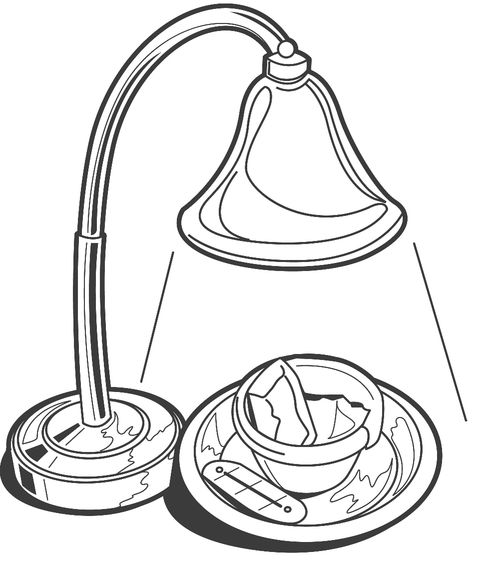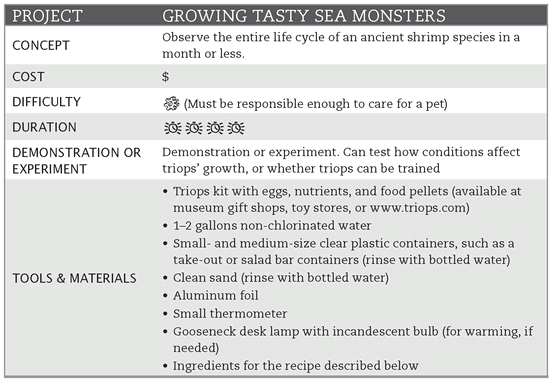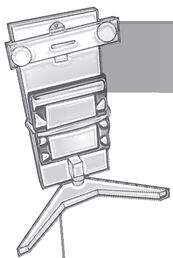Growing Tasty Sea Monsters
Idea by Kathy Ceceri
Imagine a terrifying creature that has lived in the deserts for hundreds of millions of years. It will eat pretty much anything you put in front of it, vegetable or animal. It has three eyes, so it can literally see out of the top of its head. And it is one of the most resilient creatures ever, able to go dormant and survive without water for vast spans of time, only to awaken at the first touch of moisture, revive itself, start eating again, and start reproducing.
It’s the stuff of nightmares.
But these creatures are also really cool and we can learn a lot from them. What’s more, as a mad scientist, you can raise them. You can breed them. And you can train them to do your will. They can be your very own mindless eating-machine-sea-monsters/cuddly family pets.
And, in a pinch, you can eat them in a nice garlic and butter sauce.
The sea monsters in question here are called triops. They’re a kind of desert shrimp, which complete their entire life cycle in just 20–40 days. Like horseshoe crabs (which they resemble), triops are living fossils that have basically remained unchanged since the Jurassic era.
Triops are found in pools in deserts that fill up after sudden rains and last only a few weeks before drying up again. Before the triops die, they lay eggs that are fertilized and become cysts. When the pool dries up, the cysts remain in suspended animation. They can survive many years and stand up to extreme conditions. Once they are soaked again by rain, the cysts hatch and the triops go through their life cycle again.
They are, indeed, omnivorous. They’ll eat pretty much anything you give them (including insect larvae, and even tenderized plant roots), and they need up to 40 percent of their body mass each day to feed their growth and rapid life cycle. It’s just good for us that they only grow to about 3 inches long, or we might be in trouble (of course, if we perfect that enlarging ray, our route to world-domination may be pretty short!).
BASIC STUDY OF A TRIOPS’ LIFE CYCLE
This project is a little different from the rest in this book because we’re using an over-the-counter kit as part of our materials and procedure. This isn’t intended as a cheat, but merely a short-cut to get us to deeper, more interesting science. Plus, if you don’t have a desert nearby, it may be rather tough to find any triops on your own in the wild.
STEP 1: First, we need to hatch some triops eggs from our kit. In the small plastic container (rinsed, if it is used), add non-chlorinated (preferably distilled) water, and the eggs and nutrients from your kit. If you want to try raising several generations, only use part of the eggs from the kits. While part of our experiment involves setting up a breeding tank and growing our own future generations from the original triops, we may not succeed on the first go-around, and it’ll be handy to keep some eggs in reserve. Plus, only between one and three triops usually survive from any generation (they tend to eat each other—survival of the fittest!).
The temperature of your hatching tank should be 73–85 degrees Fahrenheit (23–30 degrees Celsius). If your laboratory (always say this word in the proper, UK English pronunciation: “lah-boor-uh-tor-ee”—it just sounds more mad-scientisty that way) is colder, cover one end of the tank with aluminum foil for shade and shine a gooseneck lamp with an incandescent bulb (if available) on the tank for warmth. If you’ve mandated all compact fluorescents in your lab, you could try letting the exhaust air from a laptop computer blow on the container. Point is, you need to maintain the temperature carefully, neither letting it get too cold for them to grow, or so warm that they cook (at least not yet). Put a small room thermometer near the tank to monitor the temperature.
STEP 2: To feed your triops, start by introducing drops of human blood into the tanks once a day. No, not really, though that might be an interesting experiment—will triops feed on human flesh? See if you can get any (un)willing subjects to provide samples!
Actually, within a day or so of rehydrating your triops eggs, you’ll see tiny triops swimming around. This early, they can feed on the nutrients included in the kit, so no worries. Since these are basically microscopic organisms, they really don’t need much to grow on, even if they are doubling in size every day. But if you need more nutrients for them, you can use a little water from a nearby pond or puddle. There’s sure to be plenty of happy microscopic organisms for your triops to eat there!
When the triops are big enough to feed (a few days), you can begin giving them crushed food pellets from the kit, as directed. After a week you can feed the triops bits of carrot and brine shrimp (live or frozen, available from most pet stores that deal in fish) in addition to food pellets.
Excellent, you have raised your first generation of triops to maturity. You granted them life, you control their environment, and you can provide, or take away, their means of existence. You are as a god unto them. Will you be a benevolent or wrathful god? And, really, what now? All this power is great, but don’t let it go to your head. The next step is vital for ensuring your ongoing divinity.
From the Mad Scientist’s Notebook
There’s more to taking care of your triops than just keeping them warm and feeding them each day. You’ll also need to change some of their tank water each day, replacing it with clear, distilled water again. But change no more than 25 percent of the tank water on any given day, or the stress will kill the triops.
The Web site
www.mytriops.com has pretty much all the information you’ll ever need to be a successful triops care-person, so check it out.
STEP 3: Now we’re going to set up a breeding tank so you can continue your little (no size jokes, please—it may hurt the triops’ little feelings) family.
When your triops get big enough to be crowded in their initial tank, prepare a larger tank. Put a thin layer of clean sand on the bottom of your container and carefully move the triops over (a gentle pour from tank one to two will work). The triops will make interesting patterns in the sand as they trawl for foods. They will also lay eggs in the sand. After a few days in this tank, you can move the live ones to another container, and then let this one dry out completely. Let it sit a few days or more, and then (when you’re ready) add water and nutrients just like you were starting from scratch with the kit. You should get a whole new batch from the eggs that were in the sand.

What Else Can I Do?
Under normal conditions, triops double in size every day in the early days, and continue to grow visibly after that. Every few days, they shed their exoskeleton, which you can scoop out and save in a container of water so you can visually track your triops’ growth .
Knowing this, you can set up an experiment to see how a variety of different factors can affect their growth and lifespan. Set up two or more tanks with different conditions:
▶ 24-hour light v. no artificial light
▶ Different temperatures (test the extremes of the viable temperature ranges)
▶ Try a variety of nutrients, or differing feeding patterns.
▶ Vary the sizes of containers.
▶ Introduce new physical conditions into the situation—add rocks to the floor bed or swirl the water on regular intervals to replicate storms.
You can even try training your triops! According to available literature, triops can be trained using food or light.
Hypothesize whether you can induce specific behavior in your triops by conditioning with food rewards. See if you can induce them to move to a specific part of their tank by tapping, and then dropping in food. Do this for a few days, and then make the amount of time between tapping and adding food longer and longer. Can you get to the point when the triops respond to the taps without your needing to add food?
Or study the triops’ behavior when lights of different types are shone on the tank, or even parts of the tank. Research their “eyes” and hypothesize what different intensities or colors of lights might do to their behavior.
SEA MONSTERS, OR FOOD OF THE FUTURE?!
One thing we can study with this experiment is whether triops could potentially make a viable protein source for the future (consider this a preview section for Apocalypse Survival Science).
Considering their hardiness and quick life cycle, as well as their omnivorous nature, it’s not a crazy idea that growing triops as a food source might be a viable way of ensuring a sustainable, nutrient rich food. Obviously, as with most any food, it’s going to be about how you cook it (they are, after all, a shrimp—so treat them as such when cooking). I like Mediterranean fare, so here are a few suggestions:
▶ By themselves, you could add them (after cleaning and slicing into fine strips) to a sauce made by sautéing minced garlic and butter, with a little white wine added.
▶ You could brown the butter, and then add some mizithra cheese and the triops (boiled first, and chopped). Serve over an angel-hair pasta and you’ll never know the triops are even there.
▶ Braise the triops in olive oil, then chop them together with some kalamata olives, chop finely, and stuff into mushroom caps with a chunk of bleu cheese on each.

Of course, it may take a special kind of mad scientist to cook and serve creatures you’ve raised yourself, but we’ll leave that up to you. The real challenge is to see whether you can get classmates to try your delicacies when you make your science fair presentation. If you succeed, then you really do deserve to be called a mad scientist!





